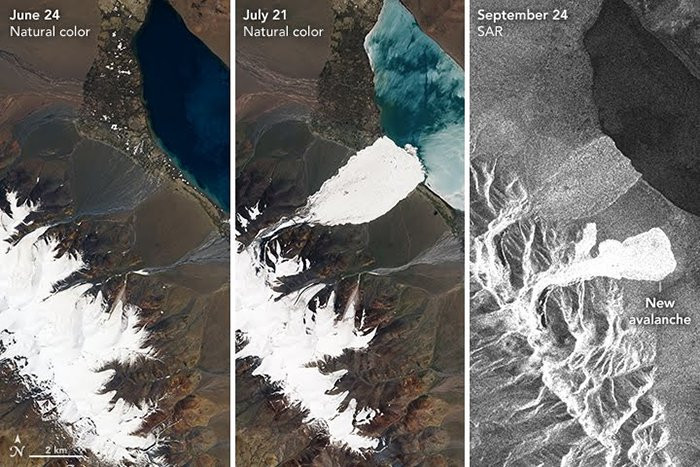Detecting two abnormal ice sheets
Scientists are investigating why Tibet has been attacked by two large icebergs like glaciers during the past two months.
The first iceberg drifted to Tibet in a large 65 million m 2 in July 2016, killing 9 groups of animals and hundreds of cattle.
The second smaller snow ice floated to Tibet in September, although it did not cause damage to animals but covered a few kilometers.
Both snow ice shelves are located near the Aru Mountains. Normal temperatures and precipitation during months and snow ice exist on flat terrain, so experts don't understand what's going on and we have to embrace the ice.

Images of icebergs in Tibet on June 24, July 21 and September 24.
Glacier researcher Andreas Kääb of the University of Oslo, Norway, said: "One of them is very unusual."
To find out what caused the first iceberg to drift, an international research group led by glacier researchers at ETH Zurich, Switzerland, built a simulation image on the iceberg computer. First to determine cracks and elevation changes.
The study was carried out before the second iceberg in September collapsed for the first time due to the phenomenon of alcohol waves. This phenomenon occurs when the ice flow from the top to the bottom of the glacier.
Alcohol waves not only cause glaciers to flow from 10 to 100 times faster than normal speeds, but also fill up the water with the foundation of liquid glaciers and collapses.
The temperature and rainfall increase in the long-term in Tibet, the river still exists in narrow valleys, causing the water to accumulate faster causing strong erosion.
Alcohol waves rarely occur in Tibet. In the framework of this study, the research team also identified another glacier of similar shape and point.
Previously, the only similar case happened with a Kolka-Karmadon iceberg in the Caucasus, Russia, in September 2012. The 19km glacier glacier was determined by ice and debris accumulated, killing more than 100 people.

Tibet.
The case of collapsing glaciers like in Tibet is rare and there is no double glacier collapse. Researchers are still puzzled yet unable to explain.
Researcher Andreas Kääb does not confirm evidence of a direct physical relationship between two unsustainable glaciers, although there are many common factors, in which weather and climatic zones seem to be the cause.
According to scientists, the consequences of climate change mean that the amount of ice on Earth is shrinking.
Is this the consequence of global warming? Or are people gradually "paying" for daily jobs? Researchers continue to learn and hope that nothing will surprise us anymore.
- Stroke risk detection tool
- Roofing from garbage
- Read this article, you will give up the habit of using red and black bed sheets
- Bed sheets can become a gathering place for scary bacteria!
- How long should you wash your bed sheets?
- Ice layers at Mount Angola, memorandum of rainfall
- Detect new abnormal chromosomes
- Be alert to abnormal changes in the body
- Warning of abnormal deaths in babies
- How to measure sea level?
- Asbestos pain of Asia
- Detecting an abnormal monster skeleton
 Is the magnetic North Pole shift dangerous to humanity?
Is the magnetic North Pole shift dangerous to humanity? Washington legalizes the recycling of human bodies into fertilizer
Washington legalizes the recycling of human bodies into fertilizer Lightning stone - the mysterious guest
Lightning stone - the mysterious guest Stunned by the mysterious sunset, strange appearance
Stunned by the mysterious sunset, strange appearance